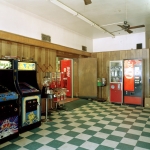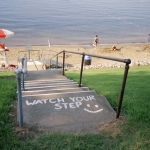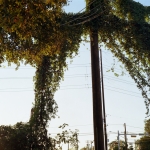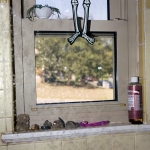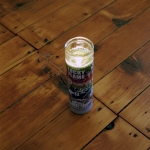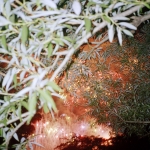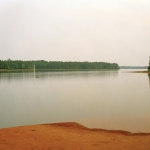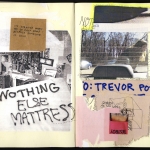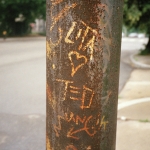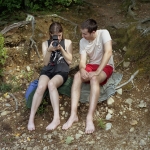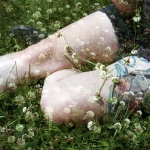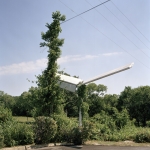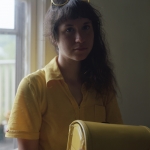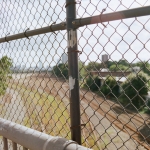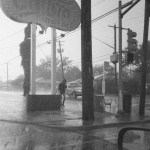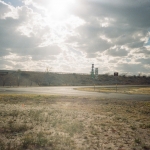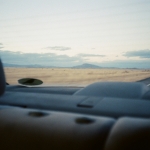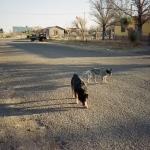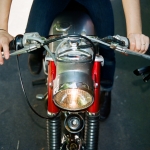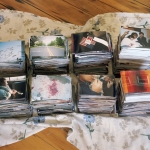From behind the lens of his 4×5, photographer Trevor Powers takes stills of life’s trivialized moments—those brief, familiar instances of beauty we so often overlook. Located in Western Mass via Vermont via Boston via Texas, Powers observes, clicks and prints photographs of his living, breathing surroundings.
Personal objects, local backdrops and friends (both two and four legged) frequent Powers’ photos; photos which he then assembles into zines: page-turning accounts of his work as an artist. Here’s his take on his craft:
Tell us a little bit about yourself and your background.
I was born, and grew up in Burlington, Vermont. I lived there until 2004 when I moved to Boston to attend The School of the Museum of Fine Arts. My main concentration at SMFA was in photography and bookmaking – working under the guidance of some amazing faculty and alongside very talent peers.
After graduating, I remained in Boston exhibiting in group shows, curating exhibitions, organizing events, and enjoying being part of the creative community. I briefly relocated to Texas for eight months between 2012 and 2013. I ate a lot of tacos, appreciated the lack of winter, adopted a dog, and enjoyed an influx of creative energy provided by completely new and unknown surroundings. I wasn’t planning on returning to New England anytime soon, but alas I am back and now reside in Western Massachusetts.
How did you become interested in and get started in photography?
Photography was omnipresent while growing up, but not in an artistic sense. Cameras, film, and prints were always around – albums upon albums spanning years and generations.
It wasn’t until the mid-to-late 90s, and when I became interested in skateboarding (and got a subscription to Transworld Skateboarding Magazine for my birthday), that I saw photography as something other than a tool used to record family gatherings and events. I began carrying around disposable cameras, taking pictures of friends skateboarding and whatever else we got into. At the same time, I was getting into the punk and hardcore scene in Burlington and began to take pictures at shows. I wasn’t musically gifted, so I think this was mostly in an effort to become an active part of this new, exciting, and accepting community.
I started to take things more seriously (and more artistically) in high school. I realized that while I loved making art, I wasn’t very good at drawing or painting. With the right type of encouragement, I realized that the photographs of my friends skating or of bands playing at 242 could actually be considered something more than a simple document.
What sorts of topics and things have you been shooting and paying attention to lately?
I’ve become increasingly interested in the idea of personal space, and how that space is defined, it’s limitations, and the objects, land, and routines that live within the space. It’s semi-autobiographical work created out of attainability and means that may not be very interesting to an outside audience, but nonetheless it’s what I’ve been drawn too lately.
What are some recurring important features in your work?
As a whole, I would say that some of the recurring features or themes that are present throughout my work are: time, space, and my relationship to those close to me.
How much of your personal life in general, informs your art?
I feel as if my art making practice in an inherent aspect of my life, and I find myself gaining the most inspiration from what’s going in my life at the moment.
Can you tell a bit about your working process when you photograph. How do you begin your projects? How many rolls will you typically shoot in a month and how often do you get them developed?
I feel as if the mode and process of photographing is dependent on the subject and format I’m using. For the most part, I use is a 4×5 field camera, scan the negatives, and print digitally. Because of the nature (and cost) of film, the time between the day of shooting and actually having a contact print in-hand can be months. That said, I would guess I don’t shoot more than 20 sheets in any given year, unless I am working on a specific project.
There was a point in college where I was shooting strictly with a 35mm point and shoot camera (see: Life is Full of Possibilities), going through 10-15 rolls a month, and getting months of film processed at once. I still shoot 35mm film now and then, and love the format, but I think I get greater pleasure from of the act of photographing with that camera than I do from the actual images. I’ve got rolls of 35 from 2010-2013 still waiting to be processed.
As far as projects go, I’ve realized I am not the type of artists who can or should formulate a project out of thin air. The photographs always come first, as my mode of working is to shoot much as I can. If I start to see a cohesive project forming, or become interested in exploring certain ideas further I will make or seek out additional images.
Recently I was speaking to a friend about the difference between digital and film. Something I’ve found is that using a digital camera almost removes you from the present, as you’re constantly referring back to what has just immediately happened. Where as with film, you don’t have that option, so you remain in the present. Then you have this distance between when the photo was taken to when it is processed, which allows you to reflect upon that moment. Do you have a preference to which technology you use?
I wouldn’t say that I have a preference on technology as much as I use what is available to me, which happens to be mostly film cameras. I am most comfortable with film, though I enjoy shooting digital and wish it was something I was better at. It’s hard for me to feel an ownership over digital images I create, and maybe that’s because they’re so immediate, whereas shooting film – 4×5 especially – is such a drawn out process.
I feel like shooting film sharpens your observational skills because you don’t have this vast amount of memory available to store images. You have to be more precise and exact.
I look at the work of Tammy Mercure, who is a prolific photographer and bookmaker, and I feel as if her observational skills get sharper and sharper because of the fact she is always shooting and making books. She’s able to be so prolific because she is shooting digitally.
Then again, within my own practice, I agree with you. Because shooting film is a bit creatively prohibitive, I spend a great deal of my time observing my surroundings, making mental notes about photographs I want to take when I get film.
What do you value in a photograph?
Heart, openness, and general willingness to show or share something with the viewer.
Why do you like about making zines? How do you start one; have a theme in mind and then shoot? Or do you collect photos for a while and then go back and curate into a zine based on a theme in the photos?
Personally, it doesn’t make sense for me to make prints the way I used to when I was in school, nor do I have the resources or space to do so. I like making zines and books because it’s a simple, economic way to display, share, and collect photographs. The best part about zines is that there are no rules, it’s a completely open format, anyone can make one, and they’re conducive to cross-medium collaboration and exploration.
The way I start a new zine is that I will have a group of images that I think would work well together – visually play off each other, or create a story. Conversely, I may have a quick one liner that I want explore in the zine or book format and will create work specifically for that (see: Length of Visible Light). Because I view zines as somewhat ephemeral, non-precious objects, I try not to overthink the process too much, and just make something I am happy with. And if halfway through I hate it, I’ll still try to see it through until the end and move on as soon as I can.
What’s next for you in the second half of 2014?
I am planning a collaborative video/mail art project with my good friend Philip Fryer, which will be my first time working in video. However, for the most part I will be preparing for a solo show happening in March 2015 at a gallery out here in Western Mass. I’ll be showing selections from the Dog Holes series, displayed as more of an installation than a traditional photo show, so I’ll be shooting more this summer and playing around with installation ideas.
What are you listening to, looking at, and reading these days?
Listening: Lots of TED Radio Hour podcasts
Looking: Less photography, more sculpture – specifically the work of Andy Coolquitt
Reading: The Answer Is Never: A Skateboarder’s History of the World by Jocko Weyland
For more photos, zines and prints from Trevor Powers go here.



